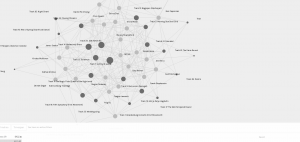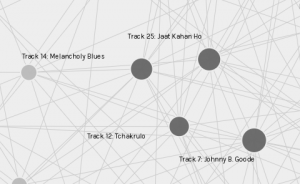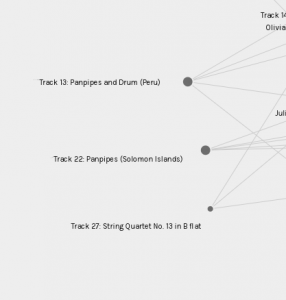
Fig 1: An overview of the entire network of songs and students. The darker circles are tracks and the lighter grey are students.
When analyzing this graph, we see it has undirected edges between nodes. The information does not change if we choose to highlight the nodes representing students or the nodes representing song tracks. When either students or tracks are highlighted, we can see the multitude of connections between the nodes.
I’ve chosen to have the targets, or tracks, highlighted and the size of the song node represent the quantity of students that chose it. Essentially, the larger the dot, the more students chose it for their Golden Record. It is interesting that this graph does not have numbers within the nodes to give a precise number of how many students chose the track. As a result, this means the weight, or importance, of each node is determined by its size. After analyzing the graph, it is evident there is a high degree of connectivity between four songs.

Fig 2: High connectivity between Track 7 “Johnny B. Goode,” Track 25 “Jaat Kahan Ho,” Track 14 “Melancholy Blues,” and Track 12 “Tchakrulo”
Focusing on the four songs with high connectivity, one could interpret that these songs were chosen because they seem to represent the typical sounds of both eastern and western music. It could be assumed with these choices that students wanted to make sure they diversified the tracks they chose. “Johnny B Goode” and “Melancholy Blues” tick off the criteria of “western” music with their English lyrics and blues rhythm. “Jaat Kahan Ho” and “Tcharkrulo” have more “eastern” instrumental melodies and both tracks have lyrics in different languages, Hindi and Georgian. By intentionally choosing these tracks, students made sure it was known they were looking to diversify their choices.

Fig 3: Shows that percussion and “typical” western classics have lower connectivity.
As shown in Figure 3, typical western classics and percussion songs have lower degrees of connectivity. I think that this is because it can be harder to identify the culture of a percussion track and, with this task, students were trying to be mindful in picking a diverse selection of songs. I don’t know if the data can ever truly reflect the “null choices.” One interpretation that classical western pieces were not chosen as often might be because they are too obvious in their representation of western culture. Choosing more than one might be too influential in our limited number of tracks. Having only 10 tracks to choose, you have to be mindful to create a diverse selection of songs.
References:
Systems Innovation. (2015, April 18). Graph Theory Overview. Retrieved from https://youtu.be/82zlRaRUsaY
Systems Innovation. (2015, April 19). Network Connections. Retrieved from https://youtu.be/2iViaEAytxw